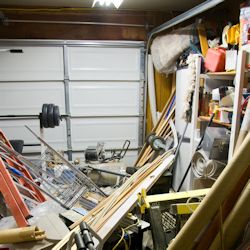Obstructions and Clutter
Injuries can also result from trips caused by reasons other than slippery surfaces, namely inadvertent contact with obstacles or other types of material (debris) and/or equipment. For example, obstacles could include obstructions across hallways, material stacked or dumped in passageways, cluttered worksites, and the list can go on.

As mentioned earlier, good housekeeping is still the most effective control measure in avoiding slips, trips and fall hazards. This means having policies or procedures in place and allowing time for cleaning the area, especially where scrap material or waste is a by-product of the work operation.
Keep aisles and corridors clean, clear, and in good repair to the maximum extent possible. This is especially true in office environments where there is a common tendency to store or stack material, especially boxes, in hallways and corridors. Not only is this an unsafe practice conducive to a tripping hazard, but also a source of fuel in the event of a fire.
Use this checklist to test your compliance with OSHA's walking and working surfaces standards for the general industry.
Knowledge Check Choose the best answer for the question.
3-5. What's the best way to prevent slip, trip, and fall accidents?
You forgot to answer the question!
